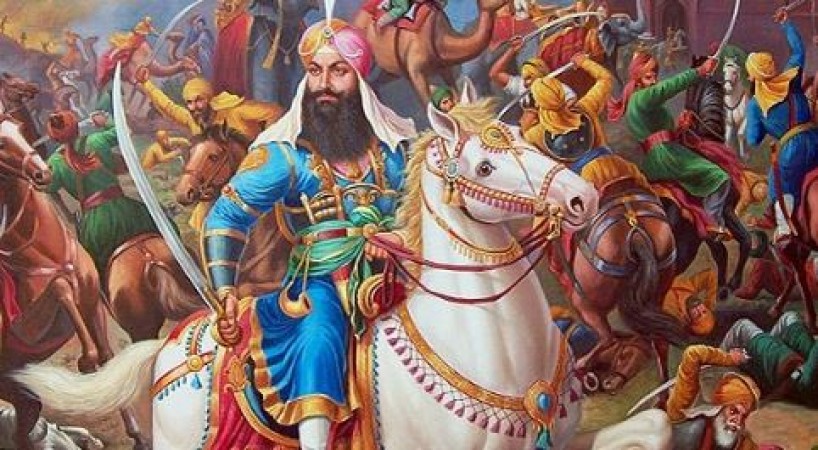
During the Sikh Confederacy era, Jassa Singh Ramgarhia (1723–1803) was a famous Sikh leader. He rose to the position of Misldar, or Chief/Leader, of the Ramgarhia Army. This time frame, which roughly spanned from Banda Singh Bahadur's passing in 1716 to the establishment of the Sikh Empire in 1801, was a transitional phase. The Age of the Misls is another name for the period.
Jassa Singh Ramgarhia is not to be confused with Jassa Singh Ahluwalia both were prominent Misldars of separate powerful Sikh army groups, called Misls. Ramgarhia's father was called Giani Bhagwan Singh.
In 1723, Jassa Singh Thoka, the future Ramgarhia, was born into a Tarkhan family in the village of Ichogil, close to Amritsar.
Baba Hardas Singh, his grandpa, lived in Sur Singh, a sizable village in the Lahore district. Guru Gobind Singh, the founder of the Pahul tradition and the person who conferred the initial Panj Piares, administered the Pahul, the Sikh baptismal oath, to him.
Also Read: Shaam Singh Attari: Trusted Advisors
He gave up his job as a ploughman and started working as one of the Guru's assistants. Baba Hardas Singh was only five years old when, on the orders of Aurangzeb, Guru Tegh Bahadur and his three gallant companions valiantly endured their torturous deaths in Chandi Chowk to defend the imperilled Hindu Pandits of Kashmir.
Under the direction of Guru Gobind Singh, the tenth Guru, Baba Ji served the Sikh panth. He produced a large number of Birs or handwritten copies of the Holy Granth. He collaborated with Bhai Mani Singh, a renowned Sikh martyr and scholar. He joined Banda Bahadur's army after the Guru passed away and participated in nearly every religious freedom struggle against the Mughal Empire's armies while flying the flag of the Sikh Jathedar (commander). His great-grandfather Baba Hardas Singh perished in a battle in 1716.
Also Read: DAL KHALSA: SIKH EMPIER
Bhagwan Singh, his lone child, then assumed leadership over the family. He had an even more daring personality. He moved to Ichogil, a village located around twelve miles east of Lahore. In the nearby villages, he shared the Sikh religion with the locals. He was a brave soldier and joined the army of the Imperial Mughals under Khan Bahadur, the governor of Lahore. where, as a result of his skills, he rose to the rank of distinguished officer. Khan Bahadur gave him the title of Risaldar (Commander of a Calvary unit).
Jai Singh, Jassa Singh, Khushal Singh, Mali Singh, and Tara Singh were the names of the five sons that Bhagwan Singh. Bhagwan Singh sacrificed his own life to defend the governor of Lahore in 1739 during Nadir Shah's invasion. The Persian invader's armies were defeated by Khan Bahadur, who was retained as governor. The governor handed each of Bhagwan Singh's five sons a hamlet as compensation for their bravery. Valla, Verka, Sultanwind, Tung, and Chubhal were the villages awarded. These are all currently located in the Amritsar area. Jassa Singh received Valla's share of these villages. When Khan Bahadur passed away in 1746, Jassa Singh and his adherents joined their Sikh brothers and sisters in Amritsar. One of Jhanda Singh Dhillon's closest pals was Jassa Singh Ramgarhia.
Also Read: Akali Baba Binod Singh Nihang : Changed Course of Sikh History
Adina Beg, the Afghan governor of Punjab, was looking for the heads of the Sikhs after Ahmed Shah Durrani left Lahore in 1716, and the Sikhs dispersed and fled in all directions. Jassa Singh and other members of the band sought sanctuary in the Ram Rauni mud fort near Amritsar, where they were subsequently encircled and attacked. After Adina Beg died in 1758, there was a power vacuum in Punjab. Those who had fled the Ram Rauni fort took the name Ramgarhias, and Jassa Singh was made its leader. The Ramgarhia Misal (Confederacy) was so named.
Also Read: Jassa Singh Ahluwalia: Spiritual Leader
The Riarki neighbourhood of Amritsar, Gurdaspur, and Batala (in Majha) were the areas where the Misl were most concentrated. Just outside of Amritsar, the Ramgarhia built and fortified the mud castle known as Ram Rauni. It was given that name in commemoration of Guru Ram Das, the fourth Sikh Guru, who founded the city. When the Mughals or Afghans invaded, the Dal Khalsa could always count on the more than 10,000 cavalry in his Misl, who were constantly on the march. Sikhs ruled the villages while the Mughal government maintained control over the metropolis. Banda Bahadur had destroyed the Mughal government twenty years earlier by getting rid of all taxes and the Zamindari system. The Sikhs were now only subject to a "disband" (10% of income tax).
Jassa Singh Ramgarhia occupied the area to the north of Amritsar between the Ravi and the Beas rivers. He also added the Jalandhar region and Kangra hill areas to his estate. He had his capital in Sri Hargobindpur. The large size of Jassa Singh’s territory aroused the jealousy of the other Sikh Misls.
Also Read: Chardi Kala: An Ascending Energy
Jassa Singh was eighty years old when he died in 1803. His son, Jodh Singh, developed good relations with Ranjit Singh and they never fought again.
Because of Jassa Singh Ramgarhia's Tarkhan roots, Tarkhans who became Sikhs came to be known as Ramgarhias. Jassa Singh left behind two sons Jodh Ramgarhia and Bir Ramgarhia. His four brothers Mali Singh, Jai Singh, Khushal Singh and Tara Singh.
Also Read: Shaam Singh Attari: Trusted Advisors